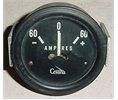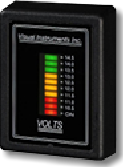Comparison of Different Electrical System Instruments
Ammeters
Most general aviation aircraft have only one instrument to monitor the electrical system.
On many older aircraft the ammeter is typically used. It is usually wired between the Alternator/generator and the battery. This configuration only provides a small amount of information as to what’s actually happening with the electrical system. Small changes in current flow are difficult to detect, because the resolution of these instruments are very course. Movements of only a fraction of a needle width are often the only indication of a failure. Ammeters give almost no information as to weather the electronics buss (supply) is being maintained at the proper level.
Is the Alternator charging? Or is this simply Parallax? It’s hard to tell
Voltmeters
Later Aircraft are usually equipped with a voltmeter. This is a great improvement over the ammeter. Voltage is a much more intuitive measurement and most pilots have a much easier time detecting electrical problems with them. There are several drawbacks with some of these factory voltmeter installations. First these voltmeters usually very small and lacks the resolution necessary to decipher small voltage changes and failures may go unnoticed. The other problem is that voltmeters are often located on the extreme right side of the panel making especially difficult to see from the left seat (out of sight out of mind). Parallax caused by reading the meter from such an angle can contribute a significant amount of error in the readings.
Multi Function Monitors
There are many new digital instruments on the market that monitor a number of different parameters of one is sometimes voltage. These multi function units can be difficult to program and use as they have many settings and display modes often requiring many button pushes to scroll though the various screens and settings.
Visual Instruments Voltage Monitor
The Visual Instruments Voltage Monitor is dedicated to one function only, it is always on, always monitoring, there is nothing turn on, nothing to set. The Multi-Color display is very viewable and makes interpretations obvious and intuitive.
The meter can be mounted in either vertical (as shown) or in a horizontal orientation. Both vertical & horizontal labels are included with the installation kit, you can choose which one best suits your preferences. A switch on the back of the Monitor sets the display’s configuration to either ‘Bar Graph’, or ‘Dot’ mode (one led lit at time). The FAA requires the configuration switch to be set to ‘Dot mode’ for STC approval.


COPYRIGHT 2013-2016 | VISUAL INSTRUMENTS INC.